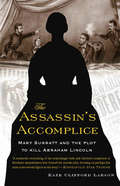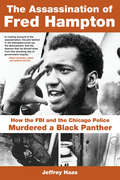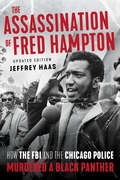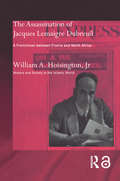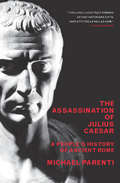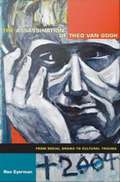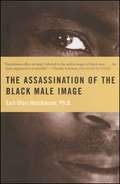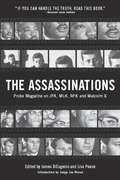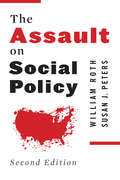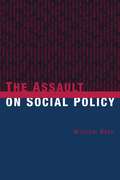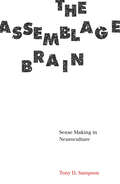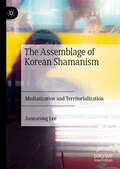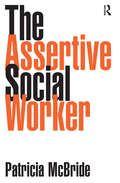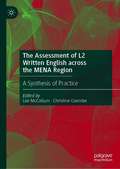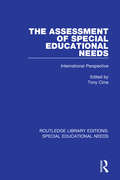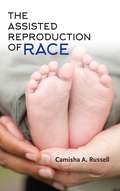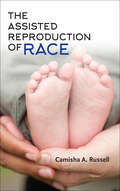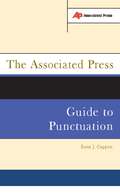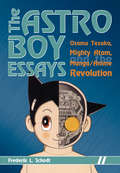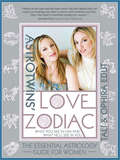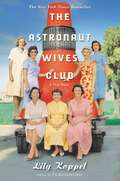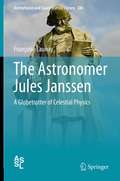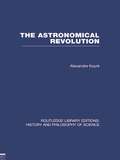- Table View
- List View
The Assassin's Accomplice
by Kate Clifford LarsonSet against the backdrop of the Civil War, The Assassin’s Accomplice tells the gripping story of the conspiracy to assassinate Abraham Lincoln through experience of its only female participant. Confederate sympathizer Mary Surratt ran a boarding house in Washington, and the depth of her complicity in the murder of President Lincoln has been debated since she was arrested on April 17, 1865. Calling upon long-lost interviews, confessions, and court testimony, historian Kate Clifford Larson magnificently captures how Surratt’s actions defied nineteenth-century norms of piety and allegiance. A riveting account of espionage and murder, The Assassin’s Accomplice offers a revealing examination of America’s most remembered assassination.
The Assassination of Fred Hampton: How the FBI and the Chicago Police Murdered a Black Panther
by Jeffrey HaasUncovering a cold-blooded execution at the hands of a conspiring police force, this engaging account relentlessly pursues the murderers of Black Panther Fred Hampton. Documenting the entire 14-year process of bringing the killers to justice, this chronicle also depicts the 18-month court trial in detail. Revealing Hampton himself in a new light, this examination presents him as a dynamic community leader whose dedication to his people and to the truth inspired the young lawyers of the People's Law Office, solidifying their lifelong commitment to fighting corruption. Contending with FBI stonewalling and unlimited government resources bent on hiding a darker plot, this reconstruction relates an inspiring narrative of upholding morality in one man's memory.
The Assassination of Fred Hampton: How the FBI and the Chicago Police Murdered a Black Panther
by Jeffrey HaasOn December 4, 1969, attorney Jeff Haas was in a police lockup in Chicago, interviewing Fred Hampton's fiancée. She described how the police pulled her from the room as Fred lay unconscious on their bed. She heard one officer say, "He's still alive." She then heard two shots. A second officer said, "He's good and dead now." She looked at Jeff and asked, "What can you do?" Fifty years later, Haas finds that there is still an urgent need for the revolutionary systemic changes Hampton was organizing to accomplish. With a new prologue discussing what has changed—and what has not—The Assassination of Fred Hampton remains Haas's personal account of how he and People's Law Office partner Flint Taylor pursued Hampton's assassins, ultimately prevailing over unlimited government resources and FBI conspiracy. Not only a story of justice delivered, the book puts Hampton in the spotlight as a dynamic community leader and an inspiration for those in the ongoing fight against injustice and police brutality.
The Assassination of Jacques Lemaigre Dubreuil: A Frenchman between France and North Africa (History and Society in the Islamic World)
by William A. Hoisington, Jr.This is a political biography of the French industrialist and political activist Jacques Lemaigre Dubreuil (1894-1955), president of the Taxpayers' Federation in the 1930s, entrepreneur in wartime France and Africa, organizer of the 'Group of Five' in Algiers which prepared for the Allied landings in North Africa (November 1942), 'inventor' of General Henri Giraud as a candidate for the leadership of liberated North and West Africa, negotiator of the Murphy-Giraud Agreements and the Anfa Memorandum with President Roosevelt (1942 and 1943), political writer on the postwar future of France in Morocco and the owner of the liberal newspaper Maroc-Presse. He was assassinated in Casablanca by French counter-terrorists in June 1955, a 'turning point' event which pushed the French government to grant independence to Morroco. Was he a rabble-rouser, a demagogue, a betrayer of French interests at home and overseas or a reformer, a patriot, a hero of the anti-German resistance, and a champion of Franco-Moroccan solidarity?
The Assassination of Julius Caesar: A People's History of Ancient Rome (A\new Press People's History Ser.)
by Michael Parenti&“A provocative history&” of intrigue and class struggle in Ancient Rome—&“an important alternative to the usual views of Caesar and the Roman Empire&” (Publishers Weekly). Most historians, both ancient and modern, have viewed the Late Republic of Rome through the eyes of its rich nobility—the 1 percent of the population who controlled 99 percent of the empire&’s wealth. In The Assassination of Julius Caesar, Michael Parenti recounts this period, spanning the years 100 to 33 BC, from the perspective of the Roman people. In doing so, he presents a provocative, trenchantly researched narrative of popular resistance against a powerful elite. As Parenti carefully weighs the evidence concerning the murder of Caesar, he adds essential context to the crime with fascinating details about Roman society as a whole. In these pages, we find reflections on the democratic struggle waged by Roman commoners, religious augury as an instrument of social control, the patriarchal oppression of women, and the political use of homophobic attacks. The Assassination of Julius Caesar offers a whole new perspective on an era thought to be well-known. &“A highly accessible and entertaining addition to history.&” —Book Marks
The Assassination of Theo Van Gogh: From Social Drama to Cultural Trauma
by Ron EyermanIn November 2004, the controversial Dutch filmmaker Theo van Gogh was killed on a busy street in Amsterdam. A twenty-six-year-old Dutch citizen of Moroccan descent shot van Gogh, slit his throat, and pinned a five-page indictment of Western society to his body. The murder set off a series of reactions, including arson against Muslim schools and mosques. In The Assassination of Theo van Gogh, Ron Eyerman explores the multiple meanings of the murder and the different reactions it elicited: among the Amsterdam-based artistic and intellectual subculture, the wider Dutch public, the local and international Muslim communities, the radical Islamic movement, and the broader international community. After meticulously analyzing the actions and reputations of van Gogh and others in his milieu, the motives of the murderer, and the details of the assassination itself, Eyerman considers the various narrative frames the mass media used to characterize the killing. Eyerman utilizes theories of social drama and cultural trauma to evaluate the reactions to and effects of the murder. A social drama is triggered by a public transgression of taken-for-granted norms; one that threatens the collective identity of a society may develop into a cultural trauma. Eyerman contends that the assassination of Theo van Gogh quickly became a cultural trauma because it resonated powerfully with the postwar psyche of the Netherlands. As part of his analysis of the murder and reactions to it, he discusses significant aspects of twentieth-century Dutch history, including the country's treatment of Jews during the German occupation, the loss of its colonies in the wake of World War II, its recruitment of immigrant workers, and the failure of Dutch troops to protect Muslims in Srebrenica in 1995.
The Assassination of the Black Male Image
by Earl Ofari HutchinsonIn The Assassination of the Black Male Image, noted political analyst and media critic Dr. Earl Ofari Hutchinson offers a searing, controversial indictment of our society’s attitudes toward black men. The black male image, he argues, has been battered, maligned, and assaulted by academics, the press, and Hollywood, as well as by some black rappers, comedians, feminists, filmmakers, and novelists—many of whom he accuses of reinforcing, and profiting from, ethnic and sexual stereotypes. Offering both a wide historical perspective and acute insights into such racially charged events as the O. J. Simpson trial, the Clarence Thomas hearings, and the Million Man March, Hutchinson brilliantly counters the image of the black male as a figure entrenched in crime, drugs, and violence. At the same time, he issues a deeply moving call to rethink the way we view African-American men.
The Assassinations
by James Dieugenio Lisa Pease"Probing deep into four hidden histories... the material released should dispel any notions of 'lone nuts' or coincidence... These articles cut a clear path through the thick jungle of disinformation that has grown around these events and expose the truly hideous teratomas that thrive and bloom under the canopy of 'national security.'"--New York Press
The Assault on Social Policy
by William Roth Susan PetersA number of groups have intensified their attack on social policy over the past ten years, and this revised textbook reflects these developments, along with new research on the hotly contested policy areas of poverty, welfare, disability, social security, and health care. This edition also considers the recent, ongoing effects of globalization and economic challenges on social policy and includes a new chapter on education.
The Assault on Social Policy
by William Roth Susan PetersBased on incisive analyses of economic globalization, class, politics, and bureaucracy, The Assault on Social Policy examines the ordinary speech used to make poverty and extreme inequality seem acceptable, the corporate strategies co-opting the distribution of wealth and other resources, and the negative effect of these efforts on our more vulnerable citizens, such as those with disabilities, incarcerated individuals, children, and the elderly. <P><P>This second edition incorporates new research on the hotly contested policies dealing with poverty, welfare, disability, social security, and health care. It also takes stock of the ongoing effects of globalization and adds a chapter on education.
The Assault on Social Policy
by William Roth Susan PetersAmerican social policy today largely serves global corporate interests rather than the general public, according to William Roth. Based on incisive analyses of economic globalization, class, politics, and bureaucracy, The Assault on Social Policy argues that the perfection of the free market is a myth. Roth analyzes the rhetoric used to make poverty seem acceptable, shows how corporations affect the distribution of wealth and other resources, and considers the effect on disabled people, criminals, children, and health care. He concludes that increased transnational corporate power has created the need for large-scale systematic public policy changes.
The Assemblage Brain: Sense Making in Neuroculture
by Tony D. SampsonOnce upon a time, neuroscience was born. A dazzling array of neurotechnologies emerged that, according to popular belief, have finally begun to unlock the secrets of the brain. But as the brain sciences now extend into all corners of cultural, social, political, and economic life, a yet newer world has taken shape: &“neuroculture,&” which goes further than ever before to tackle the profound ethical implications we face in consequence.The Assemblage Brain unveils a major new concept of sense making, one that challenges conventional scientific and philosophical understandings of the brain. Drawing on Deleuze and Guattari, Tony D. Sampson calls for a radical critical theory that operates in the interferences between philosophy, science, art, and politics. From this novel perspective the book is structured around two questions: &“What can be done to a brain?&” and &“What can a brain do?&” Sampson examines the rise of neuroeconomics in informing significant developments in computer work, marketing, and the neuropharmaceutical control of inattentiveness in the classroom. Moving beyond the neurocapitalist framework, he then reestablishes a place for proto-subjectivity in which biological and cultural distinctions are reintegrated in an understanding of the brain as an assemblage. The Assemblage Brain unravels the conventional image of thought that underpins many scientific and philosophical accounts of how sense is produced, providing a new view of our current time in which capitalism and the neurosciences endeavor to colonize the brain.
The Assemblage of Korean Shamanism: Mediatization and Territorialization
by Joonseong LeeThe most unique aspect of Korean shamanism is its mysterious duality that continually reiterates the processes of deterritorialization and reterritorialization. This book approaches that puzzle of mysterious duality using an interdisciplinary lens. Korean shamanism has been under continuous oppression and marginalization for a long time, and that circumstance has never dissipated. Shaman culture can be found in every corner of people’s lives in contemporary Korea, but few acknowledge their indigenous beliefs with pride. This mysterious duality has deepened as the mediatization process of Korean shamanism has developed. Korean shamanism was revived as the dynamic of shamanic inheritance in the process, but these dynamics have also become the object of mockery. For this reason, any true understanding of Korean shamanism rests in how to unravel the unique puzzles of this mysterious duality. In this book, the duality is mapped out by playing with the puzzles surrounding the contextualization of Korean shamanism and mediatization.
The Assertive Social Worker
by Patricia McBrideWould you like to feel more in control of yourself and your work? To cope comfortably with any demands the day throws at you? Deal easily with situations without guilt or worry? If so, this is the book for you! Social work is a stimulating and exciting career - but it can also be frustrating and exhausting. It’s easy to get so caught up in the challenges of work that it becomes difficult to see the wood from the trees. If only you were able to step back. The Assertive Social Worker will provide you with the tools to do just that and, as a result, will empower you to do your job better. By treating assertiveness as a set of skills which can be learned, practised and refined, the author opens the door to a way of thinking and behaving which can turn your whole life around. Although assertiveness may not traditionally have been associated with social work or the broader range of caring professions, it is based upon respect for yourself and others - a clear parallel with the underlying principles of your chosen career.
The Assessment of L2 Written English across the MENA Region: A Synthesis of Practice
by Christine Coombe Lee McCallumThis edited book brings together contributions from different educational contexts across the Middle East and North Africa (MENA) in order to explore how L2 English writing is assessed. Across seven MENA countries, the book covers aspects of practice including: task design and curriculum alignment, test (re)development, rubric design, the subjective decision making that underpins assessing students’ writing and feedback provision, learner performance and how research methods help shed light on initiatives to improve student writing. In such coverage, chapter authors provide concrete evidence of how assessment practice is governed by their unique context, yet also influenced by international standards, trends and resources. This book will be of interest to second language teachers, assessors and programme developers as well as test designers and evaluators.
The Assessment of Special Educational Needs: International Perspective (Routledge Library Editions: Special Educational Needs #7)
by Tony ClineFirst published in 1992. Special educational needs are being defined in new ways. Changing laws and perspectives in many countries present new challenges to practitioners. The fundamental shift underlying all these changes is the idea that handicap is not an absolute phenomenon, that special educational needs are relative to a person’s environment. Once this is accepted, it is inevitable that there will be a radical re-examination of how such needs are identified and how they are assessed. This book draws together a range of contributions from leading figures in special education worldwide, to emphasise assessment in the service of prevention, of teaching, and of mainstreaming and integration. It is not enough to understand children’s individual strengths and weaknesses. The primary objective of assessment is to guide intervention, and for that purpose it must have a broader focus and not concentrate exclusively on the target individuals who appear to have disabilities or learning difficulties: the learning environment is equally important as a focus for assessment. The book is divided into three sections that explore three broad themes: empowering children and parents during the assessment process; designing assessment so that it supports the integration and mainstreaming of children rather than their segregation; and making improvements through specific approaches to assessment.
The Assisted Reproduction of Race
by Camisha A. RussellThe use of assisted reproductive technologies (ART)--in vitro fertilization, artificial insemination, and gestational surrogacy--challenges contemporary notions of what it means to be parents or families. Camisha A. Russell argues that these technologies also bring new insight to ideas and questions surrounding race. In her view, if we think of ART as medical technology, we might be surprised by the importance that people using them put on race, especially given the scientific evidence that race lacks a genetic basis. However if we think of ART as an intervention to make babies and parents, as technologies of kinship, the importance placed on race may not be so surprising after all. Thinking about race in terms of technology brings together the common academic insight that race is a social construction with the equally important insight that race is a political tool which has been and continues to be used in different contexts for a variety of ends, including social cohesion, economic exploitation, and political mastery. As Russell explores ideas about race through their role in ART, she brings together social and political views to shift debates from what race is to what race does, how it is used, and what effects it has had in the world.
The Assisted Reproduction of Race
by Camisha A. RussellA philosopher examines the social implications of assisted reproductive technologies at the intersection of race, medicine, and bioethics.The use of assisted reproductive technologies (ART)—in vitro fertilization, artificial insemination, and gestational surrogacy—challenges contemporary notions of what it means to be parents or families. Camisha A. Russell argues that these technologies also bring new insight to ideas and questions surrounding race. She does this in part by reframing ART, as medical technologies that also act as technologies of kinship.Thinking about race in terms of technology brings together the common academic insight that race is a social construction with the equally important insight that race is a political tool used in different contexts for a variety of ends. As Russell explores ideas about race through their role in ART, she brings together social and political views to shift debates from what race is to what race does, how it is used, and what effects it has had in the world.
The Associated Press Guide To Punctuation
by Rene J. CapponMore people write for the Associated Press than for any other news service, and more writers take their style and word-usage cues from this world-famous institution than from any other journalism source. In the no-nonsense, authoritative tradition of the best-selling AP Stylebook, the top editors at the AP have now written the definitive guide to punctuation. From the when and how of the ampersand to the rules for dashes, slashes, and brackets; from the correct moment for the overused exclamation point to the rules of engagement for the semicolon, The AP Guide to Punctuation is an invaluable and easy-to-use guide to the most important aspect of clear and persuasive writing.
The Astro Boy Essays
by Frederik L. SchodtThe pioneering genius of Japan's "God of Comics," Osamu Tezuka (1928-89), is examined through his life's masterwork: Tetsuwan Atomu, also known as Mighty Atom or Astro Boy, a comic series featuring a cute little android who yearns to be more human. The history of Tetsuwan Atomu and Tezuka's role in it is a road map to understanding the development of new media in Japan and the United States. Topics include Tezuka's life, the art of animation, the connection between fantasy robots and technology, spin-offs, and Astro Boy's cultural impact.Frederik L. Schodt is a translator and author of numerous books about Japan, including Manga! Manga! and Dreamland Japan. He often served as Osamu Tezuka's English interpreter. In 2009 he was received the The Order of the Rising Sun, Gold Rays with Rosette for his contribution to the introduction and promotion of Japanese contemporary popular culture.
The AstroTwins' Love Zodiac
by Ophira Edut Tali EdutDemystify men and transform any relationship. Discover what you see in him and what he'll see in you. The Astro Twins have been using the zodiac for over 15 years to help couples find the love affair of their dreams. A good relationship may mean adjusting to someone who often thinks, acts, and views the world in a way totally foreign to you. You can have a great relationship with a man of any zodiac sign--the key is to learn what makes him tick. Using this definitive guide to understand his personality, his preferences, and his values will help you decide whether you're in it for the long haul--or not. Breaking down the entire astrological anatomy of all 12 signs of men, you'll quickly discover: How he courts, flirts, and shows he's committed; How to tell if he's serious or just playing around; What turns him on and off; How to prep for your first date, his first visit to your place, and meeting his family; What he values in life, a woman, and a relationship; Why he'd cheat and how to tell if he's serious or just playing around; When it's over for good; Commonly misunderstood signals; Your best moves; Sign-by-sign compatibility--what really happens in every combination, including the conflicts, the benefits, the compromises, and the ways you'll both grow from being together.
The Astronaut Wives Club: A True Story
by Lily KoppelDiscover the true story of the women who stood beside some of the greatest heroes of American space travel. <p><p> As America's Mercury Seven astronauts were launched on death-defying missions, television cameras focused on the brave smiles of their young wives. Overnight, these women were transformed from military spouses into American royalty. They had tea with Jackie Kennedy, appeared on the cover of Life magazine, and quickly grew into fashion icons. <p><p> Annie Glenn, with her picture-perfect marriage, was the envy of the other wives; JFK made it clear that platinum-blonde Rene Carpenter was his favorite; and licensed pilot Trudy Cooper arrived with a secret that needed to stay hidden from NASA. Together with the other wives they formed the Astronaut Wives Club, providing one another with support and friendship, coffee and cocktails. <p><p> As their celebrity rose—and as divorce and tragedy began to touch their lives—the wives continued to rally together, forming bonds that would withstand the test of time, and they have stayed friends for over half a century.
The Astronomer Jules Janssen
by Françoise LaunayA physicist and an inventor, Jules Janssen (1824-1907) devoted his life to astronomical research. He spent many years traveling around the world to observe total Solar eclipses, demonstrating that a new era of science had just come thanks to the use of both spectroscopy and photography, and persuading the French Government of the necessity of founding a new observatory near Paris. He became its director in 1875. There, at Meudon, he began routine photographic recordings of the Sun surface and had a big refractor and a big reflector built. Meanwhile, he also succeeded in building an Observatory at the summit of Mont-Blanc. The story of this untiring and stubborn globe-trotter is enriched by extracts of the unpublished correspondence with his wife. One can thus understand why Henriette often complained of the solitude in which she was left by her peripatetic husband: "There are men who leave their wives for mistresses; you do it for journeys!" ... Basking in the glow of his success, Janssen was able to undertake the construction of the great astrophysical observatory of which he had dreamed. It was at Meudon that he had it built.
The Astronomical Revolution: Copernicus - Kepler - Borelli (Routledge Library Editions: History & Philosophy of Science)
by Alexandre KoyreOriginally published in English in 1973. This volume traces the development of the revolution which so drastically altered man’s view of the universe in the sixteenth and seventeenth centuries. The "astronomical revolution" was accomplished in three stages, each linked with the work of one man. With Copernicus, the sun became the centre of the universe. With Kepler, celestial dynamics replaced the kinematics of circles and spheres used by Copernicus. With Borelli the unification of celestial and terrestrial physics was completed by abandonment of the circle in favour the straight line to infinity.
The Asylum as Utopia: W.A.F. Browne and the Mid-Nineteenth Century Consolidation of Psychiatry (Psychology Revivals)
by Andrew ScullWhat Asylums Were, Are, and Ought to Be, first published in 1837, was of considerable significance in the history of lunacy reform in Britain. It contains perhaps the single most influential portrait by a medical author of the horrors of the traditional madhouse system. Its powerful and ideologically resonant description of the contrasting virtues of the reformed asylum, a hive of therapeutic activity under the benevolent but autocratic guidance and control of its medical superintendent, provided within a brief compass a strikingly attractive alternative vision of an apparently attainable utopia. Browne’s book thus provided important impetus to the efforts then under way to make the provision of county asylums compulsory, and towards the institution of a national system of asylum inspection and supervision. This edition, originally published in 1991 as part of the Tavistock Classics in the History of Psychiatry series, contains a lengthy introductory essay by Andrew Scull. Scull discusses the social context within which What Asylums Were, Are, and Ought to Be came to be written, examines the impact of the book on the progress of lunacy reform, and places its author’s career in the larger framework of the development of Victorian psychiatry as an organised profession. Through an examination of Browne’s tenure as superintendent of the Crichton Royal Asylum in Dumfries, Scull compares the theory and practice of asylum care in the moral treatment era, revealing the remorseless processes through which such philanthropic foundations degenerated into more or less well-tended cemeteries for the still-breathing – institutions almost startlingly remote from Browne’s earlier visions of what they ought to be.
